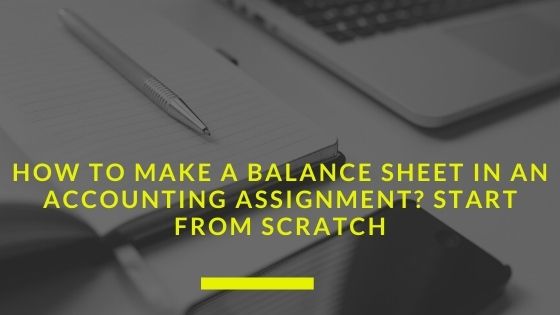Accounting is a vast subject. It is a process of recording financial transactions relating to a business. Accounting is always a core factor in every business to analyze its wax and wane.
Accounts have an immense collection of books, such as journal, ledger, profit & loss, final account, balance sheet, etc. What if you get a task to make a balance sheet in your accounting assignment, but don’t know how to do it? How will you do it on your own? You need to know the initials of making a balance sheet.

Here is a step-by-step guide to making a balance sheet easily. Follow the procedure carefully.
- Note the Reporting Date and Period
A balance sheet includes assets, liabilities, and shareholders’ equality of an organization on a certain date. These dates are referred to as the reporting date. Most of the businesses trade every quarter, and usually, their reporting date falls at the end of the quarter.
Some companies make their balance sheet annually, and they often use ‘31 December’ as their reporting date.
- Spot Your Assets
After mentioning the reporting date, you need to figure out the assets to the date. Usually, a balance sheet shows assets in two ways: As an individual asset and total assets. The reason behind separating these assets is recognizing what amount of quantity are yours, and where they came from.
An asset can be a current asset (cash and cash equivalent, inventory, short-term marketable securities, etc.) or non-current asset (Long-term marketable securities, intangible assets, goodwill, property, etc.).
- Find Your Liability
Compared to an asset, liability is a debt and an obligation for the company. It is related to other businesses or suppliers from where you borrowed something. Liability is also an entity that is compulsory to be mentioned in the balance sheet.
You also have to distinct it in an individual and total liability. It also can be in the form of current liability (Accrued expenses, account payable, commercial papers, etc.) or non-current liability (Long-term lease obligations, long-term debt, etc.).
- Calculate Shareholder’s Equity
A shareholder can be a single person or a group of different entities. If a share is held by a single owner privately, then it’s easy to calculate its part of equity. In case a company’s shares are held by a group of persons or entities publicly, it becomes difficult to calculate the shareholder’s equity.
Mention the calculated shareholder’s equity in the balance sheet. It can be common stock, treasury stock, retained earnings, etc.
- Sum of Total Liabilities to Shareholder’s Equity
In the last step, ensure the balance sheet is perfectly balanced. Total assets should be equal to the total of liabilities and equity. If the number doesn’t match, you missed something. Now recalculate each entry and then mention them in the balance sheet.
Hope now you understood the formation of a balance sheet. Follow the above steps and deal with it easily. Separate the assets and liabilities individually and also with a total. Calculate the shareholder’s equity and be careful in the final step. Make a perfect balance between assets and sum of liabilities and equity.
Summary
This article shares how you can make a balance sheet from scratch. Follow this step-by-step guide to construct a balance sheet with ease.
Author’s Bio
Casey is working as an academic writer with Global Assignment Help Australia for the last 5 years. She is an excellent writer having exemplary writing and research skills. She helps students finish their assignments, essays, homework, dissertations, and more. She loves to click pictures of nature in her free time.
